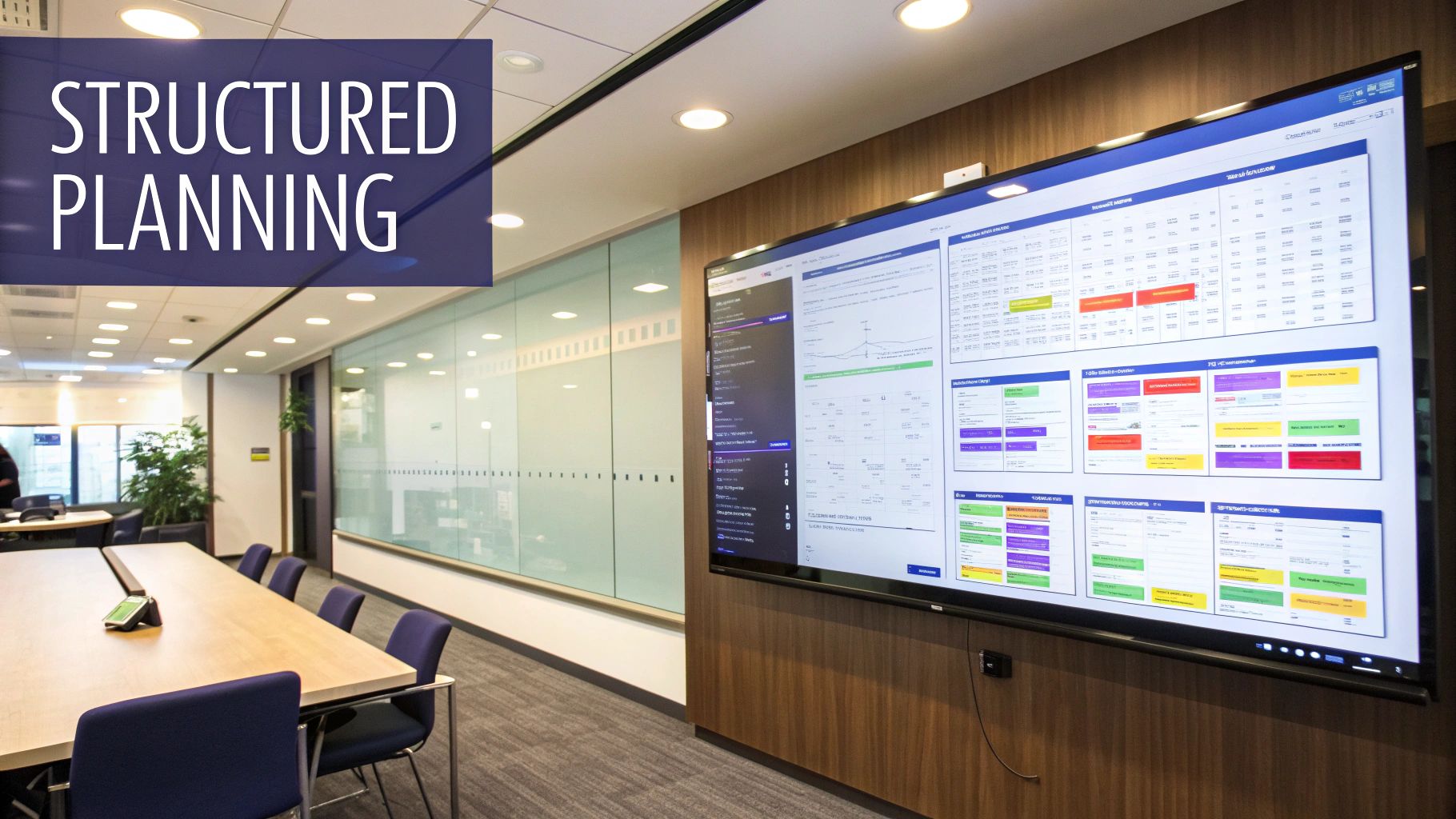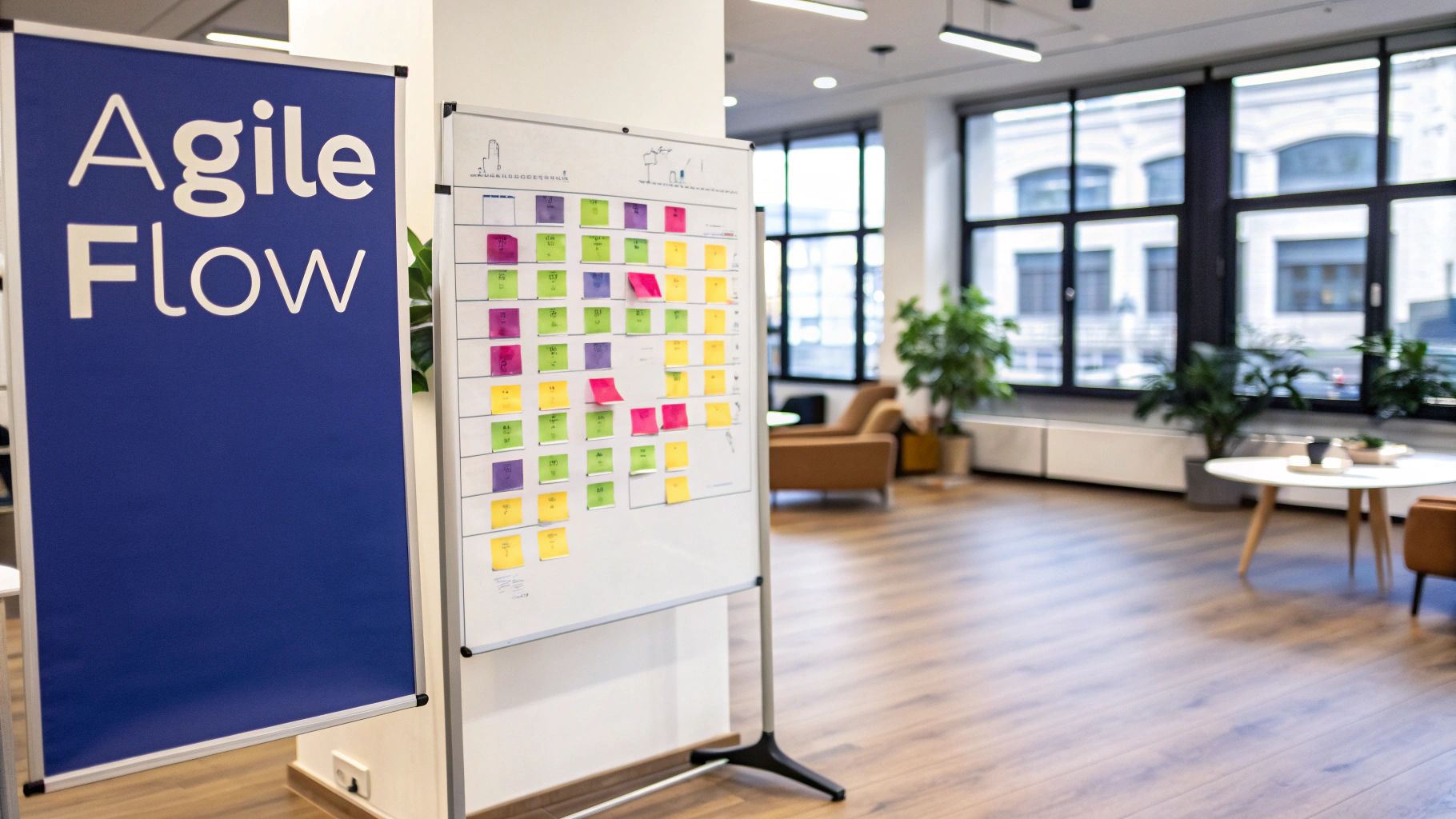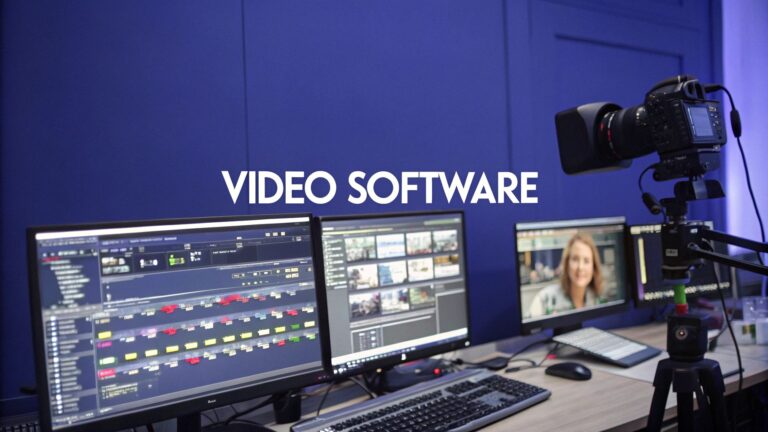Level Up Your Project Management With Documentation Templates
Successful projects, from the pyramids of Giza to the latest software release, all rely on one crucial element: meticulous documentation. While the tools have changed – from papyrus to Notion, the core principle remains. Clear, comprehensive documentation is the bedrock of effective project management. Imagine building a house without blueprints or launching a marketing campaign without a strategy. It'd be chaos. In today’s environment of dispersed teams and shifting priorities, robust documentation isn't just helpful, it's essential.
Project documentation has evolved alongside industries and project complexity. Early methods consisted of simple task lists and schedules. As projects grew more intricate, methodologies like PRINCE2 and frameworks like the PMBOK emerged. These emphasize structured documentation for risk management, communication, and quality control. But what makes documentation truly effective? Adaptability, clarity, and accessibility. A strong template provides a flexible framework, ensuring everyone is on the same page and promoting smooth collaboration.
This article helps you choose the ideal project documentation template. Whether you're a solo content creator, a startup founder, or part of a large agency, we'll explore eight powerful templates. These range from established industry frameworks to adaptable platforms, helping you streamline your workflow, reduce miscommunication, and deliver exceptional results. Prepare to take your project management from reactive to proactive and successful.
1. Microsoft Project Documentation Template
When managing complex projects, comprehensive documentation is essential. It brings clarity, improves communication, and keeps teams aligned. The Microsoft Project Documentation Template offers a powerful solution, particularly for organizations using Microsoft products. Its structured format, adherence to industry best practices, and integration with Microsoft tools make it a compelling choice for diverse project needs.

This template provides a structured framework to guide you through the entire project lifecycle. It includes pre-built sections for essential elements:
- Project Charter
- Scope Definition
- Scheduling
- Resource Allocation
- Risk Management
This structure aligns with Project Management Institute (PMI) standards, including the Project Management Body of Knowledge (PMBOK), ensuring adherence to best practices. Integrated Gantt charts offer clear visualization of timelines and dependencies. Features like the risk management matrix and change control documentation enable proactive issue mitigation and controlled adjustments.
Why Choose This Template?
The Microsoft Project Documentation Template's popularity stems from its seamless integration with Microsoft Project and the broader Microsoft Office suite. This simplifies document creation, sharing, and collaboration, especially in corporate environments where these tools are standard. Major companies like Accenture use this template for client projects, and it's a standard format for Microsoft's own internal development. Its adoption by numerous Fortune 500 IT departments for enterprise software deployments further reinforces its value.
Pros and Cons
Here’s a quick look at the advantages and disadvantages:
| Pros | Cons |
|---|---|
| Seamless Microsoft Integration | Complexity for Smaller Projects |
| Industry Recognition | Requires Microsoft Software Licenses |
| Customizable to Project Requirements | Initial Learning Curve for New Users |
| Extensive Resources and Community Support | Potential for Unnecessary Sections |
Tips for Effective Implementation
Maximize the benefits of this template with these practical tips:
- Tailor the template: Remove irrelevant sections to maintain focus and avoid unnecessary complexity.
- Version control: Track changes effectively and ensure everyone works with the most up-to-date version. Consider tools like Git.
- Consistent formatting: Use built-in styles for a professional and unified look.
- Stakeholder communication: Create simplified summaries for stakeholders who don't need all the details.
This template is a powerful tool for managing projects of all sizes. While it might be more than necessary for small projects, its comprehensive features, industry recognition, and Microsoft integration make it invaluable for larger initiatives. A simple search for "Microsoft Project Documentation Template" will reveal numerous resources and examples to help you get started.
2. Atlassian Confluence Project Documentation Template
Looking for a dynamic and collaborative way to handle project documentation? The Atlassian Confluence Project Documentation Template offers a compelling solution. Designed for the Confluence platform, this digital-first template prioritizes real-time collaboration, seamless integrations with agile development tools, and the creation of "living documentation" that evolves with your project.

Confluence’s wiki-style platform allows multiple users to contribute and edit simultaneously, minimizing delays associated with traditional methods. Features like version history and commenting ensure transparency and accountability. Teams can track changes and provide feedback directly within the platform. Plus, tight integration with Jira, Atlassian’s project management software, streamlines workflows and connects documentation to the development process.
Confluence spaces allow for organizing documentation by project aspect. Advanced search and macro support help users locate information and embed dynamic content quickly. Imagine a centralized hub where everyone can access the latest project information, fostering a shared understanding and boosting efficiency.
Benefits of Using Confluence
The benefits of this collaborative approach are significant. Real-time collaboration builds a shared understanding of project goals and progress, ideal for distributed and remote teams. Integration with development and testing tools keeps documentation relevant and up-to-date, essential for fast-paced agile methodologies.
Industry giants like Spotify, Twitter, and Airbnb have successfully used Confluence, proving its versatility and scalability. This proven track record underscores its value for various team structures and project complexities. For further insights into enhancing collaboration, check out this resource: The Best Project Feedback Tools for Seamless Collaboration.
The Rise of Confluence
The growing popularity of the Atlassian Confluence Project Documentation Template stems from the increasing adoption of agile methodologies, the rise of distributed teams, and the emphasis on collaboration and automation within the DevOps movement. Championed by Atlassian Corporation, the Agile Alliance, and DevOps thought leaders, Confluence has become central to modern project documentation.
Considering the Limitations
While Confluence offers powerful advantages, understanding its limitations is crucial. It requires an Atlassian software subscription, a potential cost barrier for some. Without proper governance, Confluence spaces can become disorganized. Its less formal structure might not suit heavily regulated industries needing strict adherence to traditional documentation standards. Finally, some team members may experience a learning curve initially.
Practical Tips for Maximizing Effectiveness
To get the most out of Confluence, consider these practical tips:
- Establish a Clear Hierarchy: A logical page hierarchy and navigation are essential for easy information access.
- Utilize Templates: Creating templates for recurring documentation (meeting minutes, reports, etc.) saves time and ensures consistency.
- Implement Tagging: Tagging enhances searchability and helps quickly locate documents.
- Schedule Regular Reviews: Regular reviews maintain accuracy, relevance, and clarity.
- Use Page Restrictions: Protect sensitive information with page restrictions.
By understanding Confluence's features, benefits, and limitations, and by applying these best practices, teams can unlock its full potential. Cultivate a truly collaborative and dynamic documentation process, driving project success and boosting team efficiency.
3. ISO 21500 Compliant Project Documentation Template
For teams and organizations that value structure and standardized processes, an ISO 21500 compliant project documentation template is a powerful tool. This template provides a comprehensive framework aligned with the internationally recognized ISO 21500 standard for project management. It ensures clear communication, consistent processes, and meticulous documentation throughout your project’s entire lifecycle.
This template isn't just a checklist; it's a blueprint for project success. By adhering to ISO 21500 guidelines, you unlock a wealth of knowledge and best practices, drawn from global experts and proven effective across various industries. This leads to streamlined communication, efficient resource allocation, and a significantly higher probability of achieving your project objectives.
Key Features and Benefits
-
Standardized Terminology: Aligning with ISO 21500 ensures everyone understands the terminology, regardless of background or location. This is especially valuable for international projects.
-
Comprehensive Process Coverage: The template covers all project phases, from initiation and planning to execution, monitoring, and closure. This thoroughness minimizes the risk of oversight and ensures smooth transitions.
-
Subject Group Documentation: A structured approach to documenting key project areas, including scope, time, cost, risk, and quality. This makes information easily accessible and supports effective decision-making.
-
Robust Quality Management: Comprehensive documentation for quality planning, assurance, and control, integrating smoothly with management systems like ISO 9001.
-
Standardized Risk Assessment: Frameworks for identifying, analyzing, and mitigating project risks, enabling proactive risk management.
-
Multi-Language Support: Facilitates global collaboration by offering multi-language support for documentation.
Pros and Cons
Pros:
- Globally Recognized Standard: Ensures consistency and simplifies collaboration with international partners.
- Ideal for Regulated Industries: Meets stringent documentation requirements common in industries like pharmaceuticals and infrastructure.
- Comprehensive Coverage: Addresses all project aspects, minimizing the risk of overlooking critical details.
- Compatible with Other Management Systems: Integrates seamlessly with ISO 9001 and other quality management systems.
Cons:
- Resource Intensive: Maintaining detailed documentation requires dedicated resources and time.
- Bureaucratic: The structured approach might feel rigid, especially in fast-paced environments.
- Training Required: Effective implementation requires staff training on ISO 21500 principles.
- Less Flexible: Compared to agile templates, it offers less flexibility in adapting to changing requirements.
Real-World Examples
Organizations worldwide use the ISO 21500 standard, including:
- Siemens: For international infrastructure projects.
- European Union Funded Projects: As a standard project documentation template.
- Pharmaceutical Companies: For clinical trial project documentation.
Tips for Implementation
- Conduct Training: Thorough training on ISO 21500 standards is essential before implementation.
- Phased Implementation: A phased approach is recommended for organizations new to formal project management.
- Regular Audits: Conduct regular audits to ensure compliance and identify areas for improvement.
- Customization: Tailor the template to your industry while maintaining core ISO requirements.
- Integration: Integrate the template with existing quality management systems for streamlined processes.
Popularized By
- International Organization for Standardization (ISO)
- Project Management Institute (PMI)
- International Project Management Association (IPMA)
While implementing an ISO 21500 compliant template requires investment, the benefits of standardized processes, comprehensive documentation, and adherence to global best practices make it an exceptional choice. This template is especially valuable for projects in regulated industries or those involving international collaborations, providing the framework for navigating complexities and achieving consistent, high-quality results.
4. Agile Project Documentation Template
In the fast-paced world of software development, clinging to traditional, cumbersome documentation can hinder progress and stifle innovation. The Agile Project Documentation Template offers a streamlined, adaptable solution, empowering teams to maintain momentum while preserving essential clarity. This template prioritizes “just enough” documentation, facilitating effective collaboration and informed decision-making—a must-have for any team embracing agile principles.

Instead of unwieldy requirements documents that quickly become obsolete, the Agile Project Documentation Template emphasizes delivering value through iterative development. This centers around key artifacts like user stories, sprint plans, and product backlogs. The template promotes “just-in-time” documentation, generating information only when necessary. Features like a structured product backlog, incremental delivery planning formats, and a clear Definition of Done (DoD) framework keep teams aligned and focused. This represents a significant departure from traditional methods, directly addressing the unique demands of agile environments.
Benefits of Agile Documentation
The minimalist approach offers compelling advantages:
- Reduced documentation overhead
- Sharper focus on delivering value
- Flexibility to adapt to evolving project needs
Companies like Spotify, Netflix, Stripe, and Square have capitalized on these benefits, showcasing the power of agile documentation in dynamic settings. Their success isn't accidental; adopting agile principles, including streamlined documentation, fuels their innovative cultures.
Challenges of Agile Documentation
While the benefits are substantial, adopting this template requires careful consideration. Disciplined adherence is crucial to ensure even minimal documentation is maintained. The lack of comprehensive detail might raise concerns for some stakeholders, requiring careful management. Adaptation may be necessary for highly regulated industries. Finally, knowledge gaps can emerge if team members depart without robust handover processes.
Tips for Successful Implementation
Successfully integrating the Agile Project Documentation Template requires a proactive approach. Here are a few essential tips:
- Focus on "Why," Not Just "How": Document the reasoning behind decisions, not merely the processes.
- Visualize: Use diagrams, Kanban boards, and other visuals to communicate complex information efficiently.
- Regular Reviews: Integrate documentation reviews into sprint retrospectives to maintain accuracy and relevance.
- Maintain ADRs: Track key technical decisions and their rationale with a lightweight Architecture Decision Record (ADR).
- Document Technical Debt: Don't ignore technical debt. Make it visible and address it strategically.
The Agile Project Documentation Template stems from the core principles of the Agile Manifesto, championed by thought leaders like Jeff Sutherland and Ken Schwaber (creators of Scrum), and organizations like the Scrum Alliance and Atlassian. This template signifies a fundamental shift in how we approach project documentation—a move towards a leaner, more agile future. By adopting this approach, your team can unlock greater efficiency, enhance collaboration, and ultimately deliver better products, faster.
5. PMI PMBOK Project Documentation Template
For projects demanding a structured and standardized approach, the PMI PMBOK Project Documentation Template stands out. Built on the Project Management Institute's globally recognized Project Management Body of Knowledge (PMBOK) Guide, this template offers a robust framework for documenting every project aspect. It aligns with the ten knowledge areas and five process groups defined within the PMBOK, making it perfect for complex projects where thorough documentation and rigorous control are essential.
First published in 1987, the PMBOK Guide has become the industry standard for project management best practices. This widespread adoption has propelled the PMBOK-based documentation template to prominence, especially in industries with strict regulations or complex project landscapes. Organizations like NASA, major defense contractors, and large construction firms utilize this framework for mission-critical projects, demonstrating its effectiveness in managing intricate details and ensuring successful outcomes.
This template equips you with a comprehensive set of documents. These include a project charter template, a structured Work Breakdown Structure (WBS) for task management, Earned Value Management (EVM) tracking for budget and schedule control, stakeholder registers and communication plans, a risk register with qualitative and quantitative analysis capabilities, and formal change control process documentation. This detailed approach reduces ambiguity, promotes clear communication, and establishes a solid foundation for project lifecycle decision-making.
Features and Benefits
-
Comprehensive Coverage: Addresses every aspect of project management, ensuring nothing is overlooked.
-
Industry Standard: Globally recognized and respected, ensuring consistency and professionalism.
-
Scalability: Ideal for large, complex projects, yet adaptable for smaller endeavors.
-
PMP Alignment: Supports Project Management Professional (PMP) certification requirements and best practices.
Pros and Cons
Here's a quick overview of the advantages and disadvantages:
| Pros | Cons |
|---|---|
| Structured, comprehensive approach | Can be document-heavy for smaller projects |
| Widely recognized in project management | Requires dedicated time for maintenance and updates |
| Ideal for large, complex projects | May be too formal for agile environments |
| Aligns with PMP certification requirements | Needs trained project management professionals |
Examples and Implementation Tips
From NASA's space missions to large-scale infrastructure projects, the PMBOK-based documentation template has proven invaluable. To maximize its effectiveness, consider these tips:
-
Tailor the Template: Adapt it to your project’s specific needs. You don't need to use every document.
-
Start Small: Focus on the core documents initially and add more as needed.
-
Plan Your Documentation: Outline required documents, responsible parties, and timelines.
-
Train Your Team: Ensure everyone understands the documentation requirements and processes.
-
Use Project Management Software: Streamline documentation and collaboration using tools like Microsoft Project or Asana.
The PMI PMBOK Project Documentation Template earns its spot on this list due to its comprehensiveness, industry recognition, and proven success with complex projects. While not suitable for every project, its structured approach provides a valuable framework for clarity, control, and ultimately, project success. While a universal template link isn't available due to customization needs, resources and templates abound online and through PMI. The template is widely promoted by the PMI, PMP-certified professionals, and organizations valuing formal project governance.
6. GitHub Project Documentation Template
Are you looking for a powerful way to manage your project's documentation? The GitHub Project Documentation Template offers a streamlined solution, especially for developers and technically-driven teams. This template brings documentation directly into your GitHub repository, making it perfect for software projects, open-source collaborations, and teams who value efficiency. Its seamless integration with the development workflow ensures consistency and encourages contribution. Why settle for scattered documentation when you can centralize it and make it a living part of your project?
This template leverages the combined strengths of Markdown and Git, keeping your documentation synced with your code. It focuses on key technical documentation elements:
-
README.md-based Project Overview: The
README.mdfile serves as the central hub. It's the first place users and contributors look, offering a concise introduction, purpose, and getting-started guide. -
CONTRIBUTING.md Guidelines: Want a thriving community? The
CONTRIBUTING.mdfile outlines clear guidelines, making it easy for external contributors to get involved and ensuring a standardized process. -
Markdown-based Wiki Integration: Build a comprehensive knowledge base with GitHub Wikis, using the familiar simplicity of Markdown.
-
Issue and Pull Request Templates: Standardize your workflow. Pre-defined templates for issues and pull requests streamline communication and guarantee consistent information.
-
GitHub Pages Support for Publishing Documentation: Publish your documentation as a readily accessible website with GitHub Pages, simplifying access for everyone.
-
Code of Conduct and License Templates: Set clear expectations for community behavior and define licensing terms, protecting your project and fostering a positive environment.
Benefits of Using The Template
Pros:
-
Documentation Lives with Code: Say goodbye to outdated documentation. Keeping it within your repository ensures synchronization and accuracy.
-
Utilizes Version Control: Track documentation changes just like code, enabling easy rollback and a clear history.
-
Supports Collaborative Contribution: Make it simple for multiple contributors to update and improve documentation, fostering a sense of shared ownership.
-
Easily Publishable as Websites: GitHub Pages makes publishing your documentation as a website effortless, broadening its reach.
Cons:
-
Primarily Focused on Technical Documentation: While excellent for developers, this template might not be ideal for documentation targeted at non-technical audiences.
-
Limited Formatting Options: Markdown offers fewer formatting options compared to rich text editors, potentially restricting visual presentation.
-
Requires Knowledge of Markdown and Git: Effective use of this template requires team members to be comfortable with Markdown and Git.
Real-World Examples
See the GitHub Project Documentation template in action with these successful projects:
-
React.js: Their open-source documentation leverages this approach for seamless contribution and maintenance.
-
TensorFlow: Both documentation and contribution guidelines follow this model, demonstrating its scalability.
Implementation Tips
Maximize the effectiveness of this template with these practical tips:
-
Start with Comprehensive README.md Files: Ensure every component or module has a detailed
README.mdexplaining its purpose and usage. -
Use Automated Documentation Tools: Integrate tools like Swagger for API documentation to generate always-up-to-date references.
-
Implement Documentation Review in Your Pull Request Process: Make documentation review a standard part of code review, ensuring quality and consistency.
-
Create Templates for Common Documentation Needs: Develop templates for recurring documentation tasks to streamline the process and maintain a uniform style.
-
Consider Tools Like Docusaurus or MkDocs: For more complex documentation sites, these tools offer advanced features like search and versioning.
The GitHub Project Documentation Template, popularized by GitHub, Microsoft, the open-source community, and even Linus Torvalds, is a proven approach for modern software projects. Adopt it and empower your team to create high-quality, maintainable documentation that evolves alongside your code. Don't just document your project; integrate it into its very core.
7. Google Docs Project Documentation Template
Looking for a project documentation solution that's both accessible and encourages collaboration? The Google Docs Project Documentation Template might be just what you need. Harnessing the power of Google Workspace, this cloud-based template offers a compelling alternative to complex project management software, especially if your team prioritizes real-time collaboration and ease of use.
Its greatest strength lies in its simplicity and accessibility. Anyone with a Google account can access, edit, and contribute to the document from any device with an internet connection. This makes it perfect for distributed teams, remote collaborators, and even external stakeholders, thanks to granular permission controls.
Real-time collaborative editing, comment and suggestion features, and version history tracking ensure everyone stays informed and can easily contribute to the project's documentation. This keeps projects moving forward and minimizes confusion.
Seamless Integration With Google Tools
The Google Docs template integrates seamlessly with other Google tools. Imagine linking to Google Sheets for project data management, building dynamic dashboards with Google Data Studio, or even using Google Forms to collect structured project information. This streamlines your workflow and centralizes vital project data, making it easier than ever to keep everything organized.
Organizations like BuzzFeed and Khan Academy, along with countless startups and small businesses, have adopted Google Docs for project documentation, proving its versatility across various industries. This widespread adoption, particularly by remote-first companies and digital agencies, highlights its effectiveness as a lightweight yet powerful project management solution.
Understanding the Limitations
It's important to acknowledge its limitations. While flexibility is a strength, it can also lead to inconsistencies, especially in larger projects. The template lacks the structured rigidity of dedicated project management software and has limited advanced project management features.
Dependency tracking, Gantt charts, and resource allocation tools are typically absent. Reliance on Google accounts for full functionality could also be a barrier for some organizations.
Tips for Maximizing Effectiveness
To get the most out of a Google Docs project documentation template, consider these tips:
- Create a master template: Ensure consistent styling and section structure.
- Utilize heading styles: Make navigation easier with the document outline feature.
- Implement regular backups: Don't rely solely on cloud storage.
- Use Google Forms: Collect structured data efficiently.
Pros:
- Accessible from any device with internet connection
- No specialized software required
- Ideal for distributed and remote teams
- Easy sharing with granular permissions
Cons:
- Less structured than dedicated project management software
- Limited advanced project management features
- Requires a Google account for full functionality
- Maintaining consistency in large projects can be challenging
Want to explore other options? Check out this article: Exploring Alternatives to Google Docs for a deeper dive into document creation tools.
By understanding the strengths and weaknesses of the Google Docs Project Documentation Template, you can leverage its accessibility and collaborative features while mitigating potential drawbacks. It’s a valuable tool for teams needing a simple, collaborative, and readily available solution for project documentation.
8. PRINCE2 Project Documentation Template
For projects demanding rigorous control and a clearly defined structure, the PRINCE2 (PRojects IN Controlled Environments) project documentation template offers a powerful solution. Originating from the UK government's need for standardization in project management, PRINCE2 has achieved global recognition, particularly in Europe and government sectors. Its strength lies in providing a structured path from project initiation to closure, benefiting diverse teams, from product development to complex client projects in digital agencies.
PRINCE2 prioritizes business justification, ensuring projects align with strategic goals from the start. The comprehensive documentation covers everything from the initial Business Case to the final Project Report, promoting transparency and accountability throughout. Defined organizational structures, product-based planning, and the principle of "management by exception" empower project managers to focus on strategy while teams manage daily tasks within agreed tolerances.
Key Features and Benefits
- Business Case Documentation Framework: Validates the project's strategic alignment and viability.
- Project Initiation Documentation (PID): Defines the project scope, objectives, and methodology.
- Stage Boundary Documentation: Enables controlled progress reviews and informed decision-making.
- Exception Reporting Templates: Simplifies escalating critical issues and deviations.
- Quality Register Formats: Maintains consistent quality and adherence to project standards.
- End Project Report Templates: Provides a structured review of outcomes and lessons learned.
Pros of Using PRINCE2
- Highly Structured Approach: Minimizes ambiguity and provides a clear roadmap.
- Clear Roles and Responsibilities: Improves communication and teamwork.
- Strong Governance Model: Ensures accountability throughout the project lifecycle.
- Widely Recognized Standard: Increases credibility and simplifies external collaboration.
Cons of Using PRINCE2
- Potential for Bureaucracy: Can be document-heavy, especially for smaller projects.
- Less Common in North America: Adoption is less widespread in this region.
- Training Requirement: Effective use requires comprehensive team training.
Real-World Examples of PRINCE2 Implementation
PRINCE2 has contributed to the success of numerous high-profile projects, including:
- UK Government IT Projects: Frequently used for managing complex tech implementations.
- National Health Service (NHS) Healthcare Technology Implementations: Applied to critical healthcare projects.
- European Financial Institutions' Regulatory Projects: Provides the structure necessary for compliance-driven initiatives.
Tips for Effective PRINCE2 Implementation
- Customization: Tailor the templates to fit your project’s unique needs.
- Essential Documentation: Prioritize essential documents to avoid unnecessary paperwork.
- Defined Roles: Clearly define responsibilities for creating and maintaining documentation.
- Technology Integration: Use electronic document management systems for efficiency.
- Training: Provide PRINCE2 training to ensure a common understanding across the team.
Organizations Associated With PRINCE2
- AXELOS: Current owners and developers of PRINCE2.
- UK Government Office of Government Commerce (OGC): Original creators of PRINCE2.
- Association for Project Management (APM): A leading professional project management organization.
The PRINCE2 project documentation template earns its place on this list by providing a robust, proven framework for managing complex projects. While not ideal for every project, its structured approach and focus on governance offer invaluable tools for teams seeking improved control, transparency, and ultimately, project success. If your project demands a high level of control and accountability, particularly in regulated environments, exploring PRINCE2 is a worthwhile endeavor. While finding generic templates directly can be challenging due to accredited training providers, searching online for "PRINCE2 templates" can uncover helpful resources.
Side-by-Side Comparison of 8 Documentation Templates
| Template | Implementation Complexity (🔄) | Resource Requirements (⚡) | Expected Outcomes (📊) | Key Advantages (⭐) | Insights/Tips (💡) |
|---|---|---|---|---|---|
| Microsoft Project Documentation Template | High – Steep learning curve & extra sections | High – Requires Microsoft licenses & Office integration | Comprehensive, PMI-aligned project details | Customizable; widely recognized in corporate settings | Remove unnecessary sections; use version control |
| Atlassian Confluence Project Documentation Template | Medium – Collaborative editing with governance challenges | Moderate – Needs Atlassian subscription & agile tool integrations | Real-time, dynamic documentation for distributed teams | Enhanced team collaboration; supports agile methodologies | Establish clear page hierarchy; schedule regular reviews |
| ISO 21500 Compliant Project Documentation Template | Very High – Detailed and compliance intensive | High – Extensive training and resource-intensive | Standardized and globally compliant documentation | Strong compliance; robust process framework | Train staff on ISO standards; perform regular audits |
| Agile Project Documentation Template | Low – Lightweight, iterative approach | Low – Minimal documentation overhead | Focused, sprint-driven documentation supporting agile delivery | Adaptive and value-driven approach | Document key decisions; incorporate sprint retrospectives |
| PMI PMBOK Project Documentation Template | High – Comprehensive and formal | High – Document-heavy; requires experienced project managers | Structured documentation covering all PMBOK knowledge areas | Widely accepted; thorough coverage for complex projects | Tailor documentation to project scale; develop an upfront plan |
| GitHub Project Documentation Template | Low–Medium – Developer-friendly with Markdown basics | Low – Integrated with code and version control systems | Synchronized technical documentation alongside code | Efficient collaboration; seamless documentation updates | Utilize README, CONTRIBUTING files; include documentation in PR reviews |
| Google Docs Project Documentation Template | Low – Easy-to-use cloud-based solution | Low – Accessible via any web browser | Accessible, real-time collaborative project documents | Easy sharing and editing; flexible and remote-friendly | Use consistent styles and document outlines; back up regularly |
| PRINCE2 Project Documentation Template | High – Structured with formal, process-driven approach | High – Requires significant training and documentation effort | Controlled documentation with clear governance and roles | Clear separation of responsibilities; strong governance | Customize templates to fit project scale; use electronic management systems |
Ready to Streamline Your Projects?
Throughout this listicle, we've explored various project documentation templates, from familiar tools like Microsoft Project and Google Docs to more specialized frameworks like ISO 21500 and PMI PMBOK. The key takeaway? Effective project documentation isn't a one-size-fits-all solution. Choosing the right template hinges on your team's specific needs, the project's complexity, and your preferred methodologies.
Whether your team embraces Agile principles, adheres to stringent industry standards, or simply seeks a more organized approach, the right template can dramatically impact your project's success.
Applying these concepts effectively requires carefully evaluating your current workflows. Consider where bottlenecks and communication breakdowns occur, and identify areas where valuable time is lost. Pinpointing these pain points enables you to select a template that directly addresses your specific challenges.
Don't hesitate to adapt and customize templates to precisely match your requirements. The ultimate goal is to create a system that empowers your team, not one that creates unnecessary obstacles.
Staying Ahead of the Curve
The project management landscape is constantly changing. New methodologies emerge, software solutions advance, and best practices are continually refined. Staying informed about these trends and remaining adaptable is critical for maximizing efficiency and delivering successful projects.
Explore new tools and techniques, experiment with different templates, and foster a culture of continuous improvement within your team.
Achieving Outstanding Results
To recap: choose a template aligned with your team's needs and project complexity, customize it as needed, and stay adaptable to evolving industry trends. Implementing these strategies will equip you to navigate the complexities of any project and achieve outstanding results.
But what about the essential feedback stage of your projects? Comprehensive documentation is just the beginning. You need a seamless method for gathering feedback, reviewing designs, and iterating on your work.
This is where BugSmash steps in. Say goodbye to juggling screenshots, emails, and disorganized spreadsheets. BugSmash allows you to upload any file type – websites, videos, PDFs, images, and more – and annotate directly on them.
Share feedback instantly with your team and clients, streamline your review process, and keep everyone aligned. Ready to experience the power of streamlined feedback? Start using BugSmash for free today and supercharge your project workflows: BugSmash




